ALL FOR THE FUTURE
Seeding Transplants? Again.
Only a couple of weeks ago I finished planting out tomato, pepper, melon, and the last of other spring transplants, and here I am today, sowing seeds again for more transplants. No, that first batch of transplants weren’t snuffed out from the last, late frost when the thermometer dropped to 28°F on May 13th.
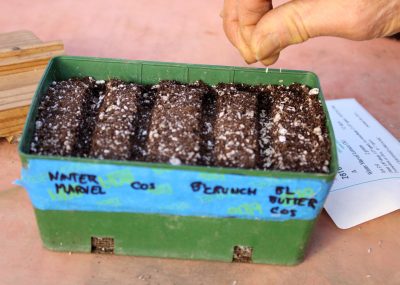
And no, those transplants were not clipped off at ground level, toppled and left lying on the ground, by cutworms. Neither were they chomped from the top down to ground level by rabbits.
I’m planting seed flats today to keep the harvest rolling along right through late autumn.
Future Further
Looking farthest ahead, I have in hand two packets of cabbage seed, Early Jersey Wakefield and Bartolo. Early Jersey Wakefield is a hundred year old variety with very good flavor and pointy heads, due to mature a couple of months after transplanting. Once those heads firm up, they can keep well out in the garden for a few weeks in the cool, autumn weather. Those I set out in spring, once mature, are apt burst open from rapid growth in summer weather. Bartolo yields firm, round heads that store in good condition after harvest, well into winter. They are ready for harvest 115 days after transplanting.
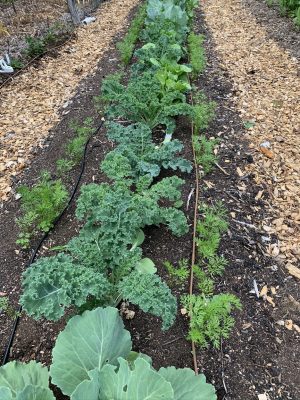
I plan for any of today’s sowings to spend about a month in their containers before being planted out. Cooler weather and lowering sunlight dramatically slow plant growth around here by early October, so any late ripening vegetables need to be ready or just about ready for harvest by then. Bartolo cabbage, with 30 days in a seed flat plus 115 days out in the garden, is then ripe by . . . whoops . . . the END of October! No wonder Bartolo often didn’t ripen for me in the past. (Nothing like writing about my garden to keep me honest and awake. I should re-read the detailed timing schedule I wrote in Weedless Gardening for various vegetables in various climates.)
Okay, all is not lost for winter storage cabbage. Warm weather, timely water from drip irrigation, and soil enriched with plenty of compost might speed maturity along faster than predicted. Unseasonally warm weather through October would also help ripen nearly ripe heads. And there’s always the fallback, with sure-to-ripen Early Jersey Wakefield.
Still on time, guaranteed, will be today’s sowing of Charming Snow cauliflower, maturing 60 days from transplanting.
That’s it, for now, for the cabbage family. Later on in summer I’ll be sowing Chinese cabbage seeds. Perhaps more kale also, although spring sowings of this almost perfect vegetable can carry on right into winter, even spring if the winter is sufficiently mild.
Future Sooner
For sooner use in the coming weeks will be today’s sowings of lettuce, cucumber, and summer squash. I like lettuce but lettuce doesn’t like hot weather and longs days. Those conditions cause leaves to turn bitter as plants send up flower stalks and go to seed. But if I sow a pinch of seeds in flats every couple of weeks, the transplanted lettuce can usually be harvested small, before it’s socked away enough energy and wherewithal to go to seed.
The cucumber transplants I’ll want on hand to replace cucumber plants that I set out a couple of weeks ago. After a few weeks those spring plantings invariably succumb to powdery mildew and cucumber beetles, which not only feed on the plants but also spread bacterial wilt disease. (Easy identification for bacterial wilt, besides a wilting plant, is the thread of bacterial ooze visible as you pull apart a cut stem.)
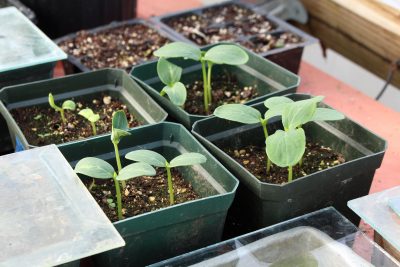
Summer squash plants also peter out during summer, mostly from, again, powdery mildew, and also from squash bugs and vine borers. If squash vines are covered with soil along their stems, roots will form at the nodes, and the plant will continue production. I’ve got to be careful in saving the older squash plants, though; it’s too easy to have too much of this vegetable.
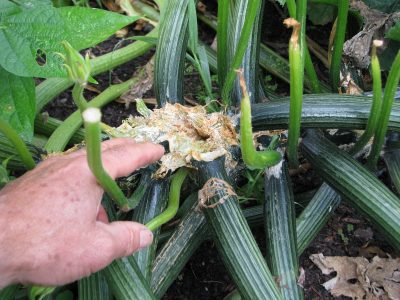
Memorial Day, Before, During, and After It
Here in the States, the traditional time to plant a vegetable garden, is for some reason, Memorial Day weekend. But that can’t be true from Oregon to Florida and from Maine to Arizona, with our wide variations in climate!
I did put tomatoes, peppers, and plenty of transplants in the ground here during Memorial Day weekend. But I already had sown seeds or transplants of peas, arugula, lettuce, kale, carrots, celeriac before that weekend. And, as I’ve written above, there’s plenty of planting to be done after that date. Memorial Day weekend is not a seminal date in my gardening calendar.

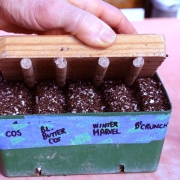

I have some ants in my lettuce. What do you advise for this cure?
What about dawn dish soap and water?
The ants are probably doing no harm. Perhaps they are “farming” aphids (which they do in exchange for the aphid honeydew), in which case the aphids are a problem. Typically, though, aphid problems disappear outdoors. You can often just hose them off the plants with nothing more than a stream of water.
I see the irrigation lines in the photo. Can you recommend a good quality brand? I don’t want to waste my money on something cheap. Thanks for the garden update! It’s always great to hear what other gardeners are doing.
Most places that sell drip stuff don’t manufacture them. So what I buy is available elsewhere also. I get my stuff from http://www.dripworks.com
Mercer County is halfway between Pittsburgh and Erie. Would Aug. 1 be an appropriate date for direct seeding of peas, bulb fennel, radicchio, escarole and endive? – Joe Wiercinski
I would start all except the peas in seed flats a month earlier. Peas are iffy since they don’t like hot weather, which it is in summer, but could grow in the cooler fall weather unless killed by frost. Worth a try if you’ve got the room.
How do you protect your plants in the cabbage family from becoming infested with cabbage worms? We have plenty of cabbage white butterfly’s. I have started to grow kale only during the winter in an unheated greenhouse due to this problem. I would like to be able to plant cauliflower, broccoli and kale out again, any suggestions? I didn’t want to have to cover them with row covers.
Periodic sprays whit Bacillus thurengiensis, sold commercially as Dipel, Thuricide, and other trade names. It is specific for lepitopterous insects such as cabbage worms.
Any advise for how to deal with cutworms? I am growing Patterson onions from seed, as I have for the last few years. Every morning, one or two of my onions are cut to the ground. I’ve tried diatomaceous earth, crushed eggshells, and finally, digging in between the rows, two inches below the soil, to try to find them. The diatomaceous earth has not worked because we have had such heavy dew lately, that it gets wet overnight, and is not very effective. Any thoughts?
Stick a toothpick about halfway into the ground right up against each plant’s stem.
Robins are eating my strawberries. I tried posting a foil pie tin tied to a stake in the middle of my berry patch to try to scare them away, but that didn’t stop them. I have netting, but don’t like using it. Do you have any suggestions? Thanks.
The netting. Use it. There are all sorts of methods suggested that work marginally or not at all.
Hi Lee,
I noticed fungus gnats in my raised beds. I believe they came in with a load of compost. What do you suggest I do? So far, no visible harm has been done to the beans, carrots and Brussels sprouts, but I don’t want to wait if I should be taking action. Thank you, Natalie
Fungus gnats rarely appear in soil outdoors. They generally prefer overly moist soils, so if they are fungus gnats you have, check the moisture levels. If things, you could use a bacteria, BTI, which is short for Bacillus thuringiensis israelensis, to kill them. It’s nontoxic to just about everything else. I would check water levels first though.
Hi Lee, I believe I may have leaf miners on my beets. I went leaf by leaf through the patch and removed little white worms clustered together on the underside of some of the leaves. I removed the leaves with a lot of damage. I cleaned up extra well all around the plants. My garden is pretty weed free as a rule especially during this time of when I am spending a lot of time at home. Other than saying a prayer or two…should I do anything more?
For me, the solution is easy: I stopped growing beets, realizing that I like neither the roots nor the leaves. For those of you who like this awful tasting vegetable, see, for instance, https://www.planetnatural.com/pest-problem-solver/houseplant-pests/leafminer-control/